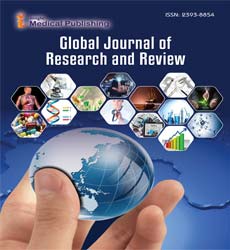ISSN : 2393-8854
Global Journal of Research and Review
Mutation Mechanisms: From Genetic Variation to Disease Development
Janos Puskas*
Department of Genetics, Yale University, Yale, USA
- *Corresponding Author:
- Janos Puskas
Department of Genetics, Yale University, Yale,
USA,
E-mail: puskas@gmail.com
Received date: July 29, 2024, Manuscript No. IPGJRR-24-19763; Editor assigned date: August 01, 2024, PreQC No. IPGJRR-24-19763 (PQ); Reviewed date: August 15, 2024, QC No. IPGJRR-24-19763; Revised date: August 22, 2024, Manuscript No. IPGJRR-24-19763 (R); Published date: August 29, 2024, DOI: 10.36648/2393-8854.11.4.114
Citation: Puskas J (2024) Mutation Mechanisms: From Genetic Variation to Disease Development. Glob J Res Rev Vol.11 No.4: 114.
Description
Mutation is a fundamental biological phenomenon that refers to a change in the nucleotide sequence of an organism's DNA. These alterations can occur in various forms, such as substitutions, deletions, insertions, or duplications of DNA segments and can arise from several sources, including environmental factors, replication errors during cell division and exposure to mutagens. Mutations play a vital role in evolution and genetic diversity, serving as the raw material upon which natural selection acts. They can lead to new traits, enabling species to adapt to changing environments, but they can also be detrimental, resulting in genetic disorders and diseases. Mutations can be classified into different types based on their effects on the DNA sequence and gene function.
Cellular functions
Point mutations involve a change in a single nucleotide base, which can be further categorized into silent, missense, or nonsense mutations. Silent mutations do not alter the amino acid sequence of the resulting protein, while missense mutations result in the substitution of one amino acid for another, potentially affecting the protein's function. Nonsense mutations create a premature stop codon, leading to the production of a truncated and often nonfunctional protein. Larger-scale mutations, such as insertions or deletions, can disrupt the reading frame of the gene, resulting in significant changes in the protein product. The consequences of mutations can vary widely. Some mutations have no observable effect on the organism, while others can confer advantages or disadvantages. For example, a mutation that enhances an organism's ability to survive in a specific environment may be positively selected, becoming more prevalent in the population over generations. Conversely, harmful mutations may lead to reduced fitness or even death, often being eliminated from the gene pool. In humans, certain mutations are linked to genetic diseases, such as cystic fibrosis or sickle cell anemia, where the altered protein function leads to specific health issues. Mutations can also contribute to cancer development. Accumulation of mutations in critical genes, such as proto-oncogenes and tumor suppressor genes, can disrupt normal cellular functions, leading to uncontrolled cell division and tumor formation. Environmental factors, such as UV radiation, smoking and certain chemicals, can increase mutation rates, highlighting the interplay between genetics and the environment in disease development. Despite their potential negative effects, mutations are essential for evolution and the diversity of life.
Genetic diversity
They provide the genetic variation necessary for populations to adapt to environmental changes, allowing species to survive in a dynamic world. For example, the development of antibiotic resistance in bacteria is a direct result of mutations that enable them to survive in the presence of antibiotics, illustrating the rapid nature of evolutionary change driven by mutation. In summary, mutations are integral to the processes of evolution and genetic diversity, with a wide range of consequences for organisms. While some mutations can lead to beneficial adaptations, others may result in genetic disorders or diseases, underscoring the dual nature of these changes. Understanding mutations and their impacts is vital in fields such as genetics, medicine and evolutionary biology, providing insights into the mechanisms of disease and the principles of evolutionary change. As research advances, the study of mutations continues to reveal the complexity of genetic variation and its implications for health, disease and the adaptability of living organisms.
Open Access Journals
- Aquaculture & Veterinary Science
- Chemistry & Chemical Sciences
- Clinical Sciences
- Engineering
- General Science
- Genetics & Molecular Biology
- Health Care & Nursing
- Immunology & Microbiology
- Materials Science
- Mathematics & Physics
- Medical Sciences
- Neurology & Psychiatry
- Oncology & Cancer Science
- Pharmaceutical Sciences
